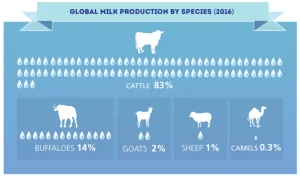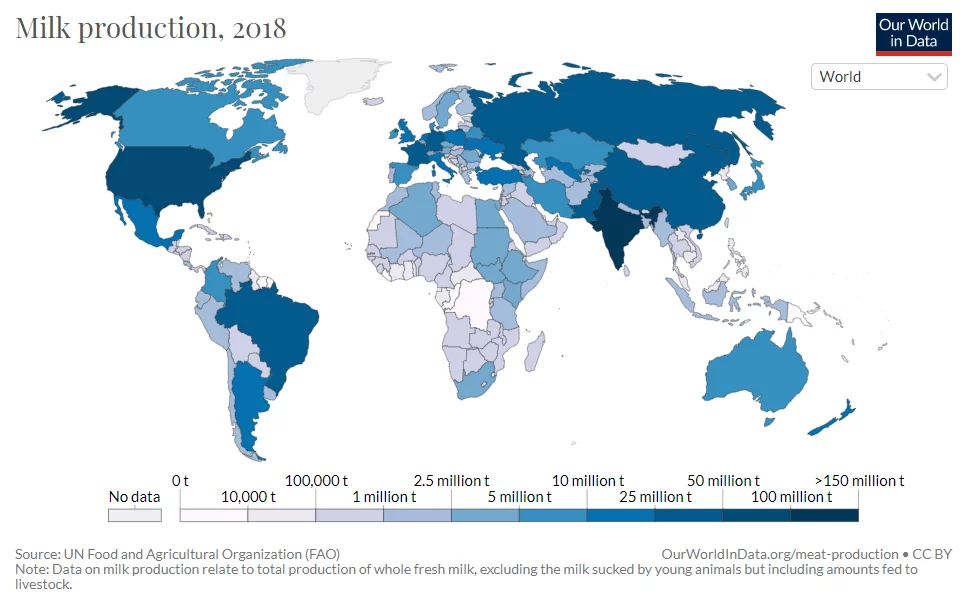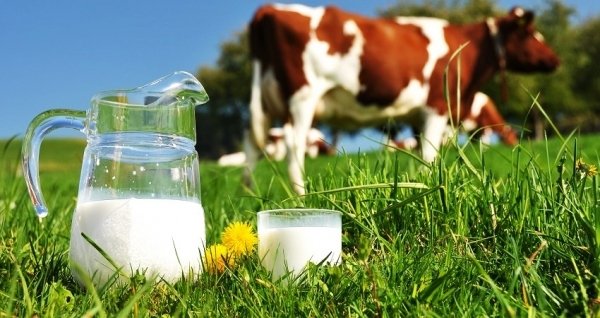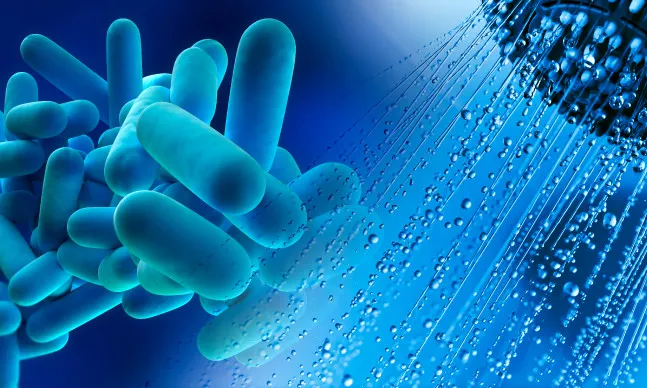Why do humans consume milk from other mammalian animals? What is its nutritional value based on the animal it comes from? What is lactose intolerance and why do some people find alternatives to drinking animal milk?
Definition of milk and historical facts
Milk is a nutrient-rich liquid food produced by the mammary glands of mammals. It is the main source of nutrition for infant mammals (including breastfeeding humans) before they can assimilate other types of food. Milk secreted by mammals immediately after birth and for a short period of time is called colostrum. Colostrum contains antibodies that provide protection for the newborn baby, as well as all the necessary nutrients and growth factors. This allows babies to be fed exclusively with milk for the first 6 months of their lives.
In many cultures, especially in the West, people continue to consume milk beyond infancy, using the milk of other mammals (especially cattle, goats and sheep) as a nutrient provider. Initially, the ability to digest milk was limited in children as adults did not produce lactase, an enzyme necessary to digest milk lactose. Lactase reaches its highest levels in the human small intestine after birth and then begins a slow decline unless milk is consumed regularly.
Thousands of years ago, a random mutation spread to human populations in Europe that allowed lactase production in adulthood. This mutation allowed milk to be used as a new food source that could feed populations when other food sources were not available.
However, those groups that continue to tolerate milk have been very creative in their use of milk from domestic ruminants, not only cattle, but also sheep, goats, yaks, buffalo, horses, reindeer and camels, depending on the area in which they live.
People first domesticated the most important dairy animals – cattle, sheep and goats.
The term milk has been defined according to the standards of the Food and Drink Code as: the colostrum-free product of the whole, uninterrupted milking of a healthy dairy animal, living and fed under healthy conditions and not in a state of overwork. The term ‘milk’ means simply, and without any adjective, only milk which: (a) comes from a cow; (b) is fresh; (c) is whole; (d) has not been dehydrated or concentrated; (e) does not contain other substances added from outside.
Where the packaged milk has different characteristics from the above, such as whether it comes from an animal other than a cow or is concentrated, this difference must be clearly indicated on the packaging.
Industrialisation
Humans first learned to consume the milk of other mammals.This development took place independently in several locations around the world from 9000-7000 BC in Mesopotamia to 3500-3000 BC in the Americas.
The growth of the urban population, combined with the expansion of the railway network in the mid-19th century, brought about a revolution in milk production and supply. Milk suppliers outside London transported milk from the countryside to the city by rail.
The first glass bottle packaging for milk was used in the 1870s.Glass milk bottles are now rare. Most people buy milk in plastic bottles or plastic-coated cartons.
In 1863, French chemist and biologist Louis Pasteur invented a method of killing harmful bacteria in drinks and food products. In honor of Pasteur, the process became known as “pasteurization”.
Pasteurization is used to kill harmful pathogens by heating milk for a short period of time and then immediately cooling it. The standard and most prevalent process is the High Temperature Short Time (HTST) method, which by heating at 72 °C for 15 seconds completely kills pathogenic bacteria in milk, making it safe for consumption for up to three weeks if it is continuously cooled.
In the western world, cow’s milk is produced on an industrial scale and is by far the most commonly consumed form of milk.

According to the Food and Agriculture Organization of the United Nations (FAO), 83% of the world’s milk production in 2016 came from cattle, 14% from buffalo, 2% from goats, 1% from sheep and 0.3% from camels.
Milk is often sold with added flavourings for better taste or as a means of improving sales. Chocolate milk has been sold for many years, followed more recently by strawberry milk and others. Some nutritionists have criticized flavored milk for adding sugar, usually in the form of fructose syrup, to the diets of children who are already obese usually in the United States. Fun fact: in a survey, 7% of adult Americans (i.e. 16.4 million) think chocolate milk is produced directly from brown cows!

Risks of unpasteurized dairy products
Microbiological hazards are a major food safety concern in the dairy sector because milk is the ideal medium for bacteria and other microbes to grow. These can be introduced into milk from the environment or from dairy animals themselves.Milk may contain harmful micro-organisms such as Salmonella, Escherichia coli O157:H7, Listeria monocytogenes, Staphylococcus aureus, Yersinia enterocolitica, Bacillus cereus, Clostridium botulinum, Mycobacterium bovis, Brucella abortus and Brucella melitensis.
The presence of pathogenic micro-organisms in raw milk initially leads to its deterioration, visually and organoleptically.The main problem, however, is the possibility of the micro-organisms causing illness in the consumer.
Consumption of raw milk containing the bacterium Brucella can cause brucellosis (or honeydew fever). Most cases of brucellosis associated with raw milk are caused by a strain called Brucella melitensis. This mainly affects sheep and goats, but cases have also been observed in cattle. The main way to prevent brucellosis is to use meticulous hygiene in the production of raw dairy products and by pasteurising all milk to be consumed by humans.
Milk and dairy products have the potential to cause serious infection in newborn infants. Unpasteurised milk and cheeses can promote the growth of Listeria bacteria. Listeria monocytogenes can also cause severe infection in infants and pregnant women and can be transmitted to their infant in utero or after birth.
Risks from unpasteurised dairy products
Microbiological hazards are a major food safety concern in the dairy sector because milk is an ideal medium for the growth of bacteria and other microbes. These can be introduced into milk from the environment or from dairy animals themselves. Milk may contain harmful micro-organisms such as Salmonella, Escherichia coli O157:H7, Listeria monocytogenes, Staphylococcus aureus, Yersinia enterocolitica, Bacillus cereus, Clostridium botulinum, Mycobacterium bovis, Brucella abortus and Brucella melitensis.
The presence of pathogenic micro-organisms in raw milk initially leads to its deterioration, visually and organoleptically. The main problem, however, is the possibility of the micro-organisms causing illness in the consumer.
Consumption of raw milk containing the bacterium Brucella can cause brucellosis (or honeydew fever). Most cases of brucellosis associated with raw milk are caused by a strain called Brucella melitensis. This mainly affects sheep and goats, but cases have also been observed in cattle. The main way to prevent brucellosis is to use meticulous hygiene in the production of raw dairy products and by pasteurising all milk to be consumed by humans.
Milk and dairy products have the potential to cause serious infection in newborn infants. Unpasteurised milk and cheeses can promote the growth of Listeria bacteria.Listeria monocytogenes can also cause severe infection in infants and pregnant women and can be transmitted to their infant in utero or after birth.
Physical and chemical properties, components of milk
Milk is an emulsion of globules of butyric acid in water containing dissolved carbohydrates and protein aggregates along with other elements. Because it is produced as a food source for newborns, its contents provide growth benefits. It contains:
Water at 80-91%, depending on the species of animal.
Lipids (triacylglycerols, small amounts of di- and monoacylglycerols, free cholesterol and cholesterol esters, free fatty acids and phospholipids). These act as emulsifiers that prevent individual globules from coalescing and protect the contents of these globules from various enzymes in the liquid part of the milk. The commercial value of milk is valued according to its fat content, but the nutritional value of its other components is high.
Proteins, mainly casein micelles and serum proteins.
Minerals and vitamins (calcium, magnesium, magnesium, sodium, potassium, citrate, phosphate and chloride ions, vitamins A, B6, B12, D, K, E, thiamine, niacin, biotin, riboflavin, folates and pantothenic acid) in free or bound form.
Sugars and carbohydrates (carbohydrates including lactose, glucose, galactose and other oligosaccharides). Lactose is a complex disaccharide of two simple sugars, glucose and galactose. Lactose levels in milk depend on the type of milk as other carbohydrates may be present in higher concentrations than lactose.
Other contents. Other components found in raw milk are live white blood cells, mammary cells, various bacteria and a large number of active enzymes (phosphatase, peroxidase, etc.).
Both the fat globules and the smaller casein micelles, which are large enough to deflect light, contribute to the opaque white colour of milk.
Milk from different mammals varies greatly in its composition. Factors such as the type of protein, the protein-fat-sugar ratio, the levels of various vitamins and minerals, the size of the butyrolipin globules and the strength of the curd are among those elements that can vary.
| Nutrient content* in raw milk of cow, sheep, goat, buffalo | ||||
| Type of milk /
content per 100g |
Cow | Sheep | Goat | Buffalo |
| Energy, kJ/kcal | 275 / 66 | 397 / 95 | 253 / 60 | 460 / 110 |
| Water, g | 87,6 | 81,5 | 85,7 | 80,5 |
| Fat, g | 3,3 – 4,0 | 7,0 – 7,6 | 4,0 – 5,0 | 8,0 – 9,2 |
| Protein, g | 3,3 | 5,7 | 3,9 | 5,2 |
| Carbohydrates, g | 4,8 | 5,1 | 4,4 | 5,2 |
| of which
Sugars, g |
4,8 | 5,0 | 4,4 | 5,2 |
| Lactose, g | 4,75 | 4,6 | 4,4 | 4,3 |
| Cholesterol, mg | 14 | 11 | 10 | 8 |
| Calcium, mg | 120 | 170 | 100 | 195 |
| Sodium, mg | 50 | 40 | 50 | 52 |
| Potassium, mg | 153 | 108 | 175 | 178 |
*indicative values

Overall, cow’s milk can be useful to improve a diet that is of poor quality, but in an otherwise healthy diet, it is unnecessary or potentially harmful.
Calcium from dairy products has a higher bioavailability than calcium contained in certain vegetables such as spinach, but similar or lower bioavailability than calcium contained in vegetables such as cabbage, broccoli or other vegetables of the genus Brassica.
Lactose intolerance
Lactose in the human stomach remains unchanged and passes into the small intestine where it is slowly broken down into glucose and galactose by the enzyme lactase. Lactose intolerance is a condition in which people have symptoms due to a lack of the lactase enzyme in the small intestine. Those affected vary in the amount of lactose they can tolerate before symptoms occur. These may include abdominal pain, bloating, diarrhoea, gas and nausea. The severity depends on the amount a person eats or drinks. Those affected can usually drink at least one glass of milk without developing significant symptoms, with larger amounts being tolerated if drunk with a meal or throughout the day.
It should be stressed that milk allergy and lactose intolerance are not the same thing. Milk allergy refers to the body reacting to the proteins in milk, while lactose intolerance is the inability to absorb lactose. If you want to learn more about allergenic foods, click here.

Reduction or elimination of lactose
Lactose-free milk can be produced by passing milk over lactase enzyme bound to an inert carrier. Once the molecule is broken down, there are no ill effects of lactose. The forms of milk available are with reduced amounts of lactose (usually 30% of normal) and alternatively with almost 0%. A glass of regular milk contains 10 g of lactose and a glass of low lactose milk contains 2 g of lactose. The only noticeable difference from regular milk is a slightly sweeter taste due to the creation of glucose due to the breakdown of lactose. However, it is nutritionally identical to regular milk.
The Finns, having a large proportion of their population lactose intolerant, are pioneers in the availability of low lactose products derived from enzymatic hydrolysis of lactose.
In addition, the Finnish Food Authority has established limits for the lactose content of products declared low lactose and lactose-free, as there are no limits at European level yet.
These are: for lactose-free food labelling, a lactose content of less than 10 mg per 100 g or 100 mL and for low-lactose food labelling, a lactose content of less than 1 g per 100 g or 100 mL.
Want to continue reading more about plant-based beverages, substitutes for animal milk? Click here
BIOCHEMIKI Analytical Laboratories, having a long experience in the analysis of raw milk and dairy products, can assist you in the microbiological and chemical analysis of your products, as well as in nutritional labelling and Quality Systems for your facilities.
With information from FAO-Dairy Products, Food and Beverage Codex, Wikipedia, Finnish Food Authority, U.S. Department of Agriculture, FoodData Central, ourworldindata.org
Translated with www.DeepL.com/Translator (free version)





